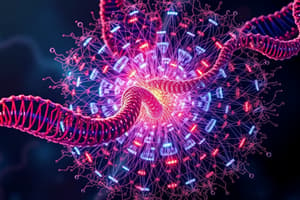Podcast
Questions and Answers
Which of the following components are included in non-coding functional sequences of DNA?
Which of the following components are included in non-coding functional sequences of DNA?
- Mobile genetic elements (correct)
- Histone proteins
- Protein-coding genes
- Ribosomal RNA
What percentage of the human genome is made up of protein-coding sequences?
What percentage of the human genome is made up of protein-coding sequences?
- 15%
- 1.5% (correct)
- 5%
- 80%
What role does the Na+/K+ ATPase play in the cell?
What role does the Na+/K+ ATPase play in the cell?
- Maintains intracellular osmolarity (correct)
- Regulates intracellular pH
- Aids in the synthesis of proteins
- Facilitates DNA replication
What mechanism allows the import of macromolecules greater than 1000 daltons into the cell?
What mechanism allows the import of macromolecules greater than 1000 daltons into the cell?
How much of DNA sequences do any two individuals share?
How much of DNA sequences do any two individuals share?
What role does receptor-mediated endocytosis primarily serve?
What role does receptor-mediated endocytosis primarily serve?
Which cytoskeletal component is NOT considered part of the intermediate filaments?
Which cytoskeletal component is NOT considered part of the intermediate filaments?
What is the primary function of gap junctions in cells?
What is the primary function of gap junctions in cells?
Which element is primarily associated with the synthesizing of membrane proteins and lipids?
Which element is primarily associated with the synthesizing of membrane proteins and lipids?
How does an acidic pH affect gap junctions?
How does an acidic pH affect gap junctions?
Study Notes
The Genome
- The genome encompasses the complete set of genes and genetic material in a cell or organism.
- Human genome consists of 23 pairs of chromosomes within cell nuclei and a small DNA molecule in mitochondria.
- Encodes approximately 20,000 proteins; protein-coding sequences make up only 1.5% of the total genome.
- Up to 80% of the genome consists of non-coding functional sequences that regulate gene expression.
- Non-coding sequences include promoter/enhancer regions, non-coding regulatory RNAs, mobile genetic elements, and special structural regions like telomeres.
Genetic Variation
- Over 99.5% of DNA sequences are shared among individuals.
- Person-to-person variation is encoded in 75 daltons, with specialized protein transporters influencing ion movement.
- Na+/K+ ATPase helps maintain intracellular osmolarity and pH, particularly crucial during cell injury.
Plasma Membrane Functions
- Plasma membrane facilitates receptor-mediated and fluid-phase uptake through endocytosis for macromolecules > 1000 daltons.
- Endocytosis methods: caveolae-mediated endocytosis, pinocytosis, and receptor-mediated endocytosis.
- Defects in receptor-mediated uptake of LDL can lead to familial hypercholesterolemia.
Cytoskeleton and Intercellular Interactions
- The intracellular cytoskeleton determines cell shape, polarity, trafficking, and motility.
- Key cytoskeletal proteins include actin microfilaments, intermediate filaments (e.g., lamin, vimentin), and microtubules.
- Cells interact through junctional complexes, including tight junctions, desmosomes (anchoring junctions), and gap junctions.
- Gap junctions, formed by connexins, facilitate communication by allowing passage of chemical and electric signals.
Biosynthetic Machinery
- All cell constituents are continuously renewed and degraded through the endoplasmic reticulum (ER).
- Rough endoplasmic reticulum synthesizes membrane proteins and secretory molecules; smooth ER is involved in lipid synthesis.
- ER stress response or unfolded protein response (UPR) can trigger apoptosis.
Waste Disposal Mechanisms
- Lysosomes degrade cellular constituents using acid hydrolases; degradation mechanisms include receptor-mediated endocytosis, autophagy, and phagocytosis.
- Proteasomes, known as "cylinders of death," degrade cytosolic and misfolded proteins, regulating macromolecule lifespan.
Mitochondria
- Often referred to as the "powerhouse" of the cell, containing its own DNA and crucial for oxidative phosphorylation.
- Mitochondria have two membranes: an inner membrane folded into cristae containing respiratory chain enzymes and an outer membrane with porin proteins.
- Sensitive to certain antibiotics and have short half-lives (1 to 10 days).
Studying That Suits You
Use AI to generate personalized quizzes and flashcards to suit your learning preferences.
Related Documents
Description
Explore the fundamental concepts of the genome and its role in cellular housekeeping. This quiz will cover key topics related to genetic material, chromosome organization, and the implications of the genome in health and disease. Perfect for students in the ABUAD MBBS 400 level course.



